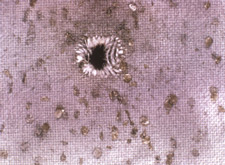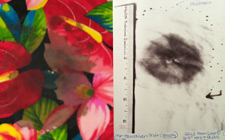Home | Glossary | Resources | Help | Contact Us | Course Map
Archival Notice
This is an archive page that is no longer being updated. It may contain outdated information and links may no longer function as originally intended.
Visual and Microscopic Examination
The preliminary visual and microscopic examinations of gunshot residues should be given first priority because subsequent chemical testing can dislodge residues or alter the appearance of physical effects.
Residues should initially be observed and evaluated by the unaided eye and with a low power (3x-30x) stereomicroscope. Infrared (IR) imaging may be used to visualize heavy soot on dark or bloody clothing. These preliminary examinations should be documented in laboratory notes. A designation for the portion of an evidence item under examination, such as an evidence item number and a hole designation (e. g., Item #23/Hole A) should be assigned.
The physical characteristics that may be visible during the preliminary examination for use in testing and interpretation include these:
- Hole in material
- Visible ring around the perimeter of a hole, sometimes referred to as bullet wipe
- Ripped or torn material in a stellate (star-shaped) pattern, consistent with a contact shot. When this is visible, especially in combination with burned, singed, or melted material, a distance determination can be made even in the absence of an evidence firearm.
- Apparently burned or singed material, such as around a suspected bullet hole
- Melted tips of artificial fibers
- Apparent heavy vaporous lead residue, often referred to as smoke, visible around a suspected bullet hole
- Burned, partially burned, or melted gunpowder adhered to the surface
- Types of gunpowder particles present (e.g., flake, disc, ball, flattened ball, etc.)
- Apparent particulate other than gunpowder (e.g., lead shavings, tiny solidified droplets, copper jacket fragments, etc.)
Additional Online Courses
- What Every First Responding Officer Should Know About DNA Evidence
- Collecting DNA Evidence at Property Crime Scenes
- DNA – A Prosecutor’s Practice Notebook
- Crime Scene and DNA Basics
- Laboratory Safety Programs
- DNA Amplification
- Population Genetics and Statistics
- Non-STR DNA Markers: SNPs, Y-STRs, LCN and mtDNA
- Firearms Examiner Training
- Forensic DNA Education for Law Enforcement Decisionmakers
- What Every Investigator and Evidence Technician Should Know About DNA Evidence
- Principles of Forensic DNA for Officers of the Court
- Law 101: Legal Guide for the Forensic Expert
- Laboratory Orientation and Testing of Body Fluids and Tissues
- DNA Extraction and Quantitation
- STR Data Analysis and Interpretation
- Communication Skills, Report Writing, and Courtroom Testimony
- Español for Law Enforcement
- Amplified DNA Product Separation for Forensic Analysts



